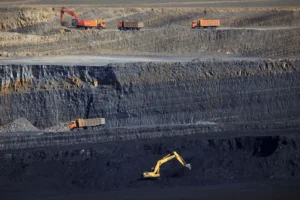
About Coal
- Known as “Black Gold,” is a type of fossil fuel that is found in sedimentary strata.
- It is a readily accessible conventional energy source.
- It is used as a fuel for homes, steam engines, iron and steel industries, and electricity generation.
- Coal-based electricity is referred to as thermal power. Among the top producers of coal worldwide are China, the United States, Australia, Indonesia, and India.
Coal Distribution in India: Ensuring Energy Access Nationwide
- Gondwana Fields Dominance:
- Gondwana coal accounts for 98% of total reserves and 99% of coal production in India.
- Found in the Godavari (Maharashtra), Damodar (Jharkhand-West Bengal), Mahanadi (Chhattisgarh-Odisha), and Namrada basins, Gondwana is renowned for its superior quality and metallurgical grade.
- Tertiary Fields:
- Tertiary fields, dating from 15 to 60 million years ago, are primarily located in extra-peninsular regions.
- These regions include West Bengal’s Darjeeling foothills in the Himalayas, Assam, Meghalaya, Nagaland, Arunachal Pradesh, Jammu & Kashmir, Rajasthan, Uttar Pradesh, and Kerala.
- Classification:
- Anthracite: Found in limited quantities in Jammu & Kashmir, anthracite coal boasts a carbon concentration of 80–95%.
- Bituminous: Predominantly found in Madhya Pradesh, West Bengal, Odisha, Chhattisgarh, and Jharkhand, bituminous states have a carbon content of 60 to 80%.
- Lignite: Found in Tamil Nadu, Lakhimpur (Assam), and Rajasthan, lignite coal exhibits a high moisture level and 40–55% carbon concentration.
- Peat: At the initial stage of converting from organic matter (wood) to coal, peat contains less than 40% carbon content.
- The Gondwana Fields, dating back 250 million years, play a pivotal role in India’s coal reserves and production. Here are key points to understand about the coal classification and distribution in India.
- Each classification of coal in India serves different purposes and has distinct characteristics, contributing to the diverse energy landscape of the country.
- Overview of Distribution:
- India heavily relies on coal for power generation, industrial processes, and domestic use.
- Reserves are concentrated in states like Jharkhand, Chhattisgarh, Odisha, and West Bengal.
- Coal India Limited (CIL) dominates coal production and distribution in India.
- Distribution Network Components:
- Complex network involving mines, railways, roads, and ports.
- Raw material transported to destinations like thermal power plants, steel plants, and industrial units.
- Railways are primary mode of transportation.
- Importance for Energy Needs:
- Essential for meeting energy demands of sectors like thermal power, steel, cement, and fertilizer.
- Requires continuous and reliable supply for uninterrupted electricity generation and industrial operations.
- Challenges in Distribution:
- Infrastructure bottlenecks leading to delays and inefficiencies.
- Issues like pilferage, theft, and illegal mining pose security and regulatory concerns.
- Initiatives for Improvement:
- Investments in modernizing railways and developing new freight corridors.
- Promotion of cleaner energy alternatives like renewable energy sources.
- Government Policies and Targets:
- Ambitious targets set for increasing the share of renewable energy.
- Efforts to reduce dependence on coal and promote cleaner technologies.
- Coal distribution is crucial for energy accessibility and economic growth in India.
- Ongoing efforts to improve infrastructure and promote cleaner energy alternatives are essential for a sustainable and efficient distribution system
FAQs
Q1: How many mines are there in CIL?
Ans:Coal India Limited (CIL) operates a total of 352 mines as of April 1, 2020. Among these mines, details of those operating with profitability or losses are provided in Annexure A and Annexure B.
Q2: What is the demand for coal in India in 2030?
Ans: As per projections from the Ministry of Coal, the demand for coal in India is anticipated to range between 1.5 to 1.8 billion tonnes (bt) by the year 2030. Officials have further indicated plans to establish a buffer stock of over an estimated 0.5 to 1 billion tonnes to manage any unforeseen demand fluctuations effectively.
Thank you for your sharing. I am worried that I lack creative ideas. It is your article that makes me full of hope. Thank you. But, I have a question, can you help me?
Your article helped me a lot, is there any more related content? Thanks!
Your point of view caught my eye and was very interesting. Thanks. I have a question for you.
Thank you for your sharing. I am worried that I lack creative ideas. It is your article that makes me full of hope. Thank you. But, I have a question, can you help me?
Thank you for your sharing. I am worried that I lack creative ideas. It is your article that makes me full of hope. Thank you. But, I have a question, can you help me?